BURLINGTON COUNTY’S HISTORIC SCHOOL HOUSES
An Illustrated Lecture by Joseph M. Laufer
Burlington County Historian
- Brainerd School – 1759.
35 Brainerd
St., Mt. Holly
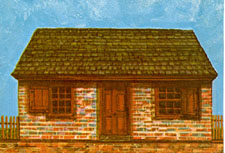

This
is the oldest school in New Jersey standing on its original site.
In June of 1759, twenty-one citizens of Mount Holly (nine Quakers, eight Episcopalians, four of unknown religion) subscribed for twenty-five shares to buy land and build a schoolhouse. Under one master or another, school was kept for over fifty years. In 1815, the surviving heirs of the builders deeded the building to the Female Benevolent Society. These women proposed to teach "in a public school all the poor children of Mount Holly and its vicinity gratis." For the next thirty-three years, over a thousand children were taught without charge. The schoolhouse remained in the possession of the Female Benevolent Society for 136 years, until 1951, when it was presented to The National Society of The Colonial Dames of America in the State of New Jersey for preservation and restoration.
The original brick work of the front and two ends remains. It is laid in flemish bond, with headers alternating with red stetchers in a familiar South Jersey style. Research established the great size and location of the fireplace. Original shutters provided a pattern for new shutters. The arched ceiling follows the original line of the hand-hewn beams, one of which is still preserved. .
Some of its
furnishings include a schoolmaster’s desk, student desks, slates and a 1752
Bible. Open by appointment: 609-267-6996.
- Clara Barton School - 1852
Crosswicks & Burlington Streets, Bordentown

Founded
as the first tax-supported free school in New Jersey in 1852 by Clara Barton, the foundress
of the American Red Cross. Ms. Barton
resided in Bordentown for two years and converted an abandoned Quaker school to
educate children at no cost. A State
“Free School Law” followed in 1871, providing elementary education. The simple gabled building houses many interesting items including Miss Barton's original desk. Open by appointment.
Link to more information about Clara Barton School
- Little Red Schoolhouse – 1812
415
West Main Street, Maple Shade
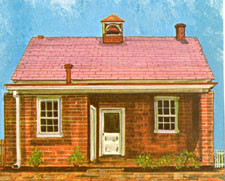

One
of the first buildings on the new road to Camden from Maple Shade (Main Street) was the
Little Red School House. In December of
1811 Joseph Burrough, for the sum of one dollar “for the natural love of
literature and divers other causes”, deeded the lot containing “two roods and
two perches”, on which he had built a one room brick school house to 11 men, seven from Burlington County and four from Camden County "as a school lot and for no other purpose". Beginning in 1812, children came to the Little Red Schoolhouse from beyond Haddonfield Road and as far away as Forklanding Bridge. In 1871 the Little Red Schoolhouse became a free school under the jurisdiction of the state, county and local authority. The Little Red Schoolhouse closed in 1909, having served 97 years. It is currently operated by the Maple Shade Historical Society.
- Friends Schoolhouse – 1792
York
St. (Between Penn & E. Union Sts.), Burlington City
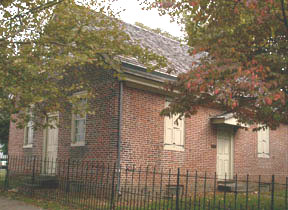
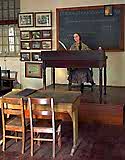
The
small brick schoolhouse housed many Quaker students who were taught the three
Rs. The Quakers stressed education,
feeling that a young person must be prepared to accept the responsibilities of
adulthood. Discipline was strict and
the students spent long hours attempting to solve the mysteries of long division
and Latin. This building contains many
photographs, books, and documents of Burlington.
Click here for more detailed information on the Friends Schoolhouse
- Billy K. Haines Schoolhouse – c.
1860
In
the Park behind Sally Stretch Keen Memorial Library, Main St. and Race St.,
Vincentown.
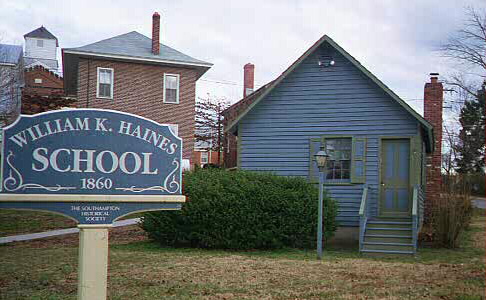
A private school known as a helping
school attended by students who needed more help than the public school could offer. The best-known schoolmaster was
Billy K. Haines. The schoolhouse
originally stood on Main Street on the property now owned by Allen Oil Co. The school was dedicated to school children
of Southampton Township on May 19, 1984.
It contains period student desks, slates, books and other teaching aids.

Interior of the Vincentown one-room schoolhouse
The archives of Southampton Township and Vincentown contain pictures of a number of one room schoolhouses, past and present, typical of other communities throughout Burlington County. For detailed information on these records, click below.
Southampton Historic Schools, past and present
- Old Juliustown Schoolhouse - closed 1918
111 Newbolds Corner Road, Southampton, NJ

There seems to be no question that the building used as a seed and feed store on the grounds of the Ed Gager Farm in Southampton is a relocated schoolhouse. Exactly which schoolhouse it was is still open to question and controversy. Ed Gager believes it was the Old Juliustown Schoolhouse which closed in 1918 (according to a 1943 book on Burlington County Schools). Ed had been told by an old-time resident that he remembers the school being transported down Smithville Road in 1919 and placed on the Gager farm. Another local resident feels it was an old schoolhouse from Smithville. Another history buff considers it one of Southampton's old one room school houses, possibly the former Lane School. Until presented with more definitive data, we tend to lean towards the present owner's rendition of history and call it the old Juliustown School.
- Willingboro School House - 1866
Salem
Road, Willingboro
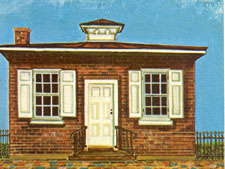

Erected
in 1866 and used as a school continuously until 1918, this uniquely designed
building was placed on the State Register of Historic Places in 1973 and is
also on the National Register of Historic Places. The building, which housed as many as 53 children in grades one
through four, is slated for restoration to its 1910 likeness.
- Georgetown School – c. 1849
Route
206, north of Columbus, Mansfield Township
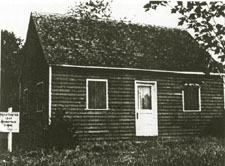

Originally
located on Gaunt’s Bridge Road this school building now sits on the North end
of the Columbus Civic & Athletic Association’s lake. A map dated 1849 shows that this school was
in use at that time. In 1914 it was
moved to the Charles Burtis Farm (now the Kenny Farm) on Route 68. The building was given to the Mansfield
Township Historical Society in 1976.
- Friendship School - c. 1890
Carranza
Road, Tabernacle
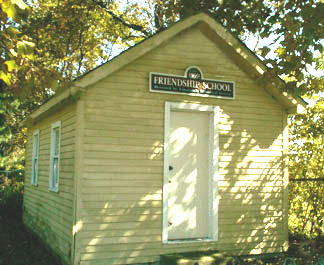
Located just past the crossroads of Tabernacle on Carranza Road, adjacent to the present Sequoia Transitional School (Tabernacle Intermediate School), where County Route 648 intersects Carranza Road, this
restored schoolhouse was moved to this location from neighboring Woodland Township. It was located on Carranza Road in Woodland and used by families who worked on the cranberry bogs in the area. The school was abandoned in 1917 for lack of pupils. It was put to various uses until rescued in 1976 by the Tabernacle Historical Society while it was being used as a goat barn. Using a bit of historical license, the Historical Society called the restored structure "Friendship School" because there had been a one room schoolhouse in Friendship ("Inawendiwin" in the language of the Lenape Indians), a small community on the north-east border of Tabernacle Township at the Southampton Township line. That school was destroyed in a fire. Before Tabernacle Township was created, Friendship, a small sawmill community, was at the juncture of three Townships: Southampton, Woodland and Shamong -- as indicated by a corner stone imbedded in tree roots in that location. The restored school house contains period desks and teaching tools. It is operated
by the Tabernacle Historical Society. By appointment: 609-268-0473.
- Cross Keys School - Est. 1857
Mill
Street, Medford
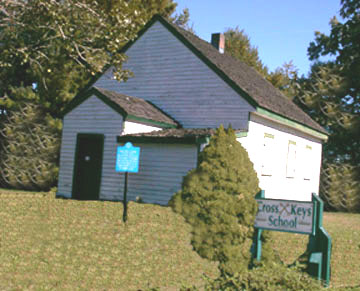
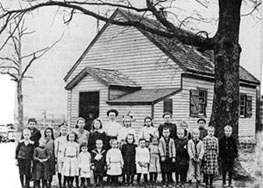
Located on the grounds of the
Medford Middle School facing Mill Street, on the left shortly after the Mill St. athletic field. As described on Medford Historic Marker #62, "Built by Lester Gager in 1857 at the corner of Dixontown Road, the school was moved to this location by the Township in 1976. Former students called it 'The Knowledge Box'." By appointment: 609-654-0768 or 609-654-5720
- Rancocas Friends School - 1822
Main
Street, Rancocas, Westampton Twp.
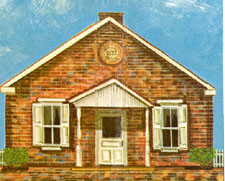
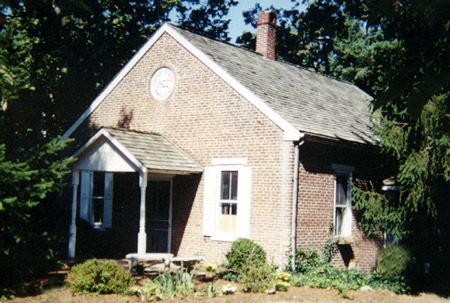
The
first Friends school was established here as early as 1703 with no regard to sex, race or
religion. It was replaced in 1773 with a frame structure
that was in use continuously until the present brick schoolhouse was built in
1822. This school, in continuous use
ever since (except for a brief period in the 1930’s), had some of the most
respectable teachers in Burlington County (among them, John Gummere, who eventually became the president of Haverford College, Charles Stokes, Laura Gaskill, Nora Dunfee, Mayberry McVaugh and Rachel Hunt). In recent years it has become a Nursery School serving the children of the community.
- Friends Lower Schoolhouse – 1791
Riverton
Road, Cinnaminson
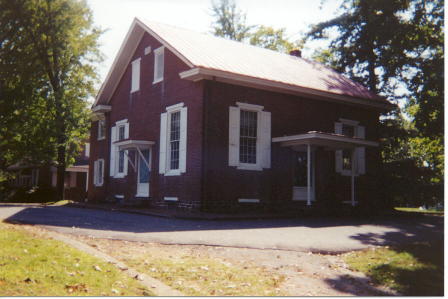
Located
on the grounds of the Westfield Friends Meeting, this two-classroom building
was referred to as Abraham Warrington’s School. In December, 1788 he established a school in his home, and by
1791 the present structure was built under the auspices of the Chester
Preparative Meeting.
-
Smithville School - c. 1865
Smithville Road and Meade Road, Eastampton
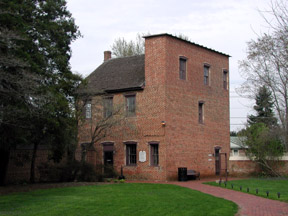
The neighborhood school at Smithville, located off the northeast corner of the mansion grounds next to the main road, was a short walk from the company houses of Smithville. It was a one-story*, one-room brick structure which served both the village and the surrounding farms. The schoolroom capacity was fifty-two persons. Although the number of registered students was sixty-seven, the average attendance was only forty-one. The town employed one male teacher to conduct class for a little over ten months a year at a salary of $45 a month. In the 1870s the school was used as the Smithville Lyceum during evening hours, hosting lectures, debates, entertainment and meetings for the community.
Note: While the school section of the structure was one story, the south end terminated in a three-story section referred to as "the lodge".
- Roebling Row-house School – 1907
159
Third Avenue, Village of Roebling, Florence Township
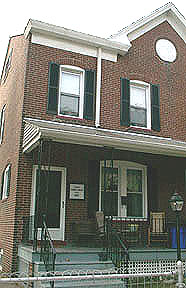

This
end row-house was first used as a school house for the village children for
grades 1-3. Miss McKensie came from
Trenton each day by train to teach the children. Eventually the Roebling Public School was constructed in 1914 and
the children were educated there. It is now a private residence.
Joseph M. Laufer
October 5, 2004